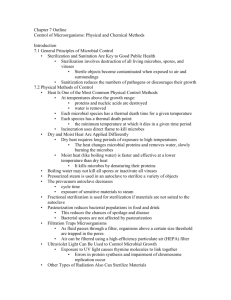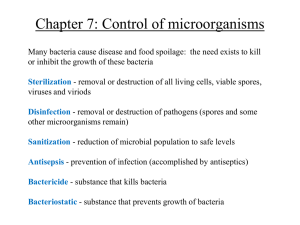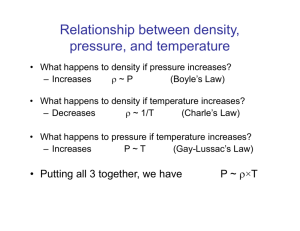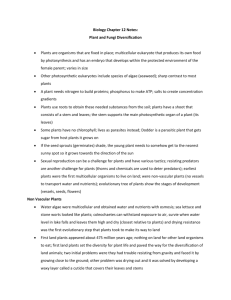Control of Microorganisms
advertisement
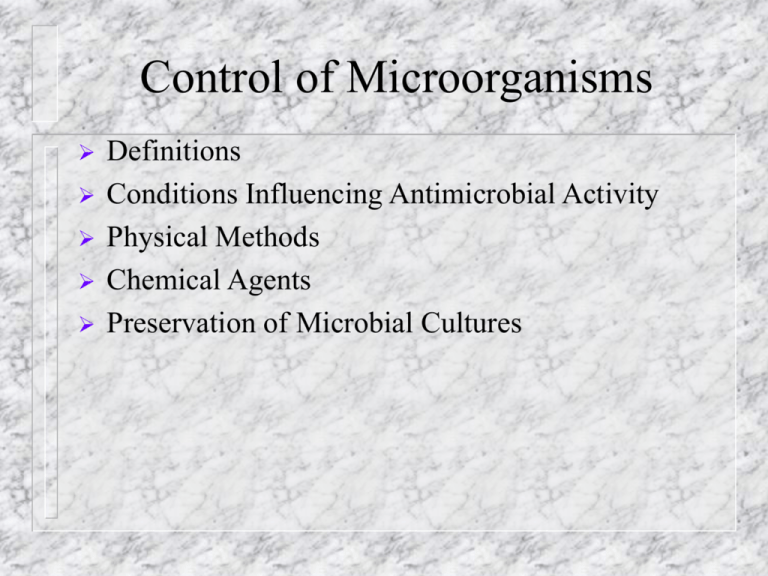
Control of Microorganisms Definitions Conditions Influencing Antimicrobial Activity Physical Methods Chemical Agents Preservation of Microbial Cultures Definitions Sterilization: A treatment that kills or removes all living cells, including viruses and spores, from a substance or object Disinfection: A treatment that reduces the total number of microbes on an object or surface, but does not necessarily remove or kill all of the microbes Definitions Sanitation: Reduction of the microbial population to levels considered safe by public health standards Antiseptic: A mild disinfectant agent suitable for use on skin surfaces -cidal: A suffix meaning that “the agent kills.” For example, a bacteriocidal agent kills bacteria Definitions -static: A suffix that means “the agent inhibits growth.” For example, a fungistatic agent inhibits the growth of fungi, but doesn’t necessarily kill it. Conditions Influencing Antimicrobial Activity Under most circumstances, a microbial population is not killed instantly by an agent but instead over a period of time The death of the population over time is exponential, similar to the growth during log phase Conditions Influencing Antimicrobial Activity Several critical factors play key roles in determining the effectiveness of an antimicrobial agent, including: Population size Types of organisms Concentration of the antimicrobial agent Duration of exposure Temperature pH Organic matter Biofilm formation Physical Methods Moist Heat Dry Heat Low Temperatures Filtration Radiation Physical Methods: Moist Heat Mechanism of killing is a combinantion of protein/nucleic acid denaturation and membrane disruption Effectiveness Heavily dependent on type of cells present as well as environmental conditions (type of medium or substrate) Bacterial spores much more difficult to kill than vegetative cells Physical Methods: Moist Heat Measurements of killing by moist heat Thermal death point (TDP): Lowest temperature at which a microbial suspension is killed in 10 minutes; misleading because it implies immediate lethality despite substrate conditions Thermal death time (TDT): Shortest time needed to kill all organisms in a suspension at a specified temperature under specific conditions; misleading because it does not account for the logarithmic nature of the death curve (theoretically not possible to get down to zero) Physical Methods: Moist Heat Measurements of killing by moist heat (cont.) Decimal reduction time (D value): The time required to reduced a population of microbes by 90% (a 10-fold, or one decimal, reduction) at a specified temperature and specified conditions z value: The change in temperature, in ºC, necessary to cause a tenfold change in the D value of an organism under specified conditions F value: The time in minutes at a specific temperature (usually 121.1°C or 250 °F) needed to kill a population of cells or spores Physical Methods: Moist Heat Calculations using D and z values Given: For Clostridium botulinum spores suspended in phosphate buffer, D121 = 0.204 min How long would it take to reduce a population of C. botulinum spores in phosphate buffer from 1012 spores to 100 spores (1 spore) at 121°C? Answer: Since 1012 to 100 is 12 decimal reductions, then the time required is 12 x 0.204 min = 2.45 min Physical Methods: Moist Heat Calculations using D and z values (cont.) Given the D value at one temperature and the z value, we can derive an equation to predict the D value at a different temperature: Db Ta Tb log( ) Da z Db 10Ta Tb /z Da Physical Methods: Moist Heat Calculations using D and z values (cont.) • • First, write an equation for this line. Since the y axis is on a log scale, then y = log (D). The slope of the line is -1/z; we’ll let the y intercept be equal to c. Therefore: T log(D) c z At a given temperature Ta, D = Da, so we can eliminate the “c” term Ta log(Da ) c z T c log(D a ) a z T T log(D) log(Da ) a z z Physical Methods: Moist Heat Calculations using D and z values (cont.) • We can explicitly refer to the second temperature and D value as Tb and Db, so: log(D b ) Tb T log(Da ) a z z log(D b ) log(Da ) Ta Tb z Db Ta Tb log( ) Da z Db 10Ta Tb / z Da Physical Methods: Moist Heat Calculations using D and z values (cont.) Given: For Clostridium botulinum spores suspended in phosphate buffer, D121 = 0.204 min and z = 10°C How long would it take to reduce a population of C. botulinum spores in phosphate buffer from 1012 spores to 100 spores (1 spore) at 111°C? Answer: To answer the question we need to know D111, which we can calculate from the formula: log(D111/0.204) = (121-111) /10 D111 = 0.204(10) = 2.04 min 12D111= 24.5 min Physical Methods: Moist Heat Calculations using D and z values (cont.) Given: For Staph. aureus in turkey stuffing, D60 = 15.4 min and z = 6.8°C How long would it take to reduce a population of Staph. aureus in turkey stuffing from 105 cells to 100 cells at 55°C, 60°C, and 65°C? Answers: Work it out for yourself. Here are the answers. At 55°C: 419 min At 60°C: 77 min At 65°C: 14.2 min Physical Methods: Moist Heat Methods of Moist Heat Boiling at 100°C • Effective against most vegetative cells; ineffective against spores; unsuitable for heat sensitive chemicals & many foods Autoclaving/pressure canning • • • Temperatures above 100°C achieved by steam pressure Most procedures use 121.1°C, achieved at approx. 15 psi pressure, with 15 - 30 min autoclave time to ensure sterilization Sterilization in autoclave in biomedical or clinical laboratory must by periodically validated by testing with spores of Clostridium or Bacillus stearothermophilus Physical Methods: Moist Heat Methods of Moist Heat Pasteurization • • • • Used to reduce microbial numbers in milk and other beverages while retaining flavor and food quality of the beverage Retards spoilage but does not sterilize Traditional treatment of milk, 63°C for 30 min Flash pasteurization (high-temperature short term pasteurization); quick heating to about 72°C for 15 sec, then rapid cooling Physical Methods: Moist Heat Methods of Moist Heat Ultrahigh-temperature (UHT) sterilization • • • Milk and similar products heated to 140 - 150°C for 1 - 3 sec Very quickly sterilizes the milk while keeping its flavor & quality Used to produce the packaged “shelf milk” that does not require refrigeration Physical Methods: Dry Heat Incineration Burner flames Electric loop incinerators Air incinerators used with ferementers; generally operated at 500°C Oven sterilization Used for dry glassware & heat-resistant metal equipment Typically 2 hr at 160°C is required to kill bacterial spores by dry heat: this does not include the time for the glass to reach the required temp (penetration time) nor does it include the cooling time Physical Methods: Low Temperatures Refrigerator: around 4°C inhibits growth of mesophiles or thermophiles; psychrophiles will grow Freezer: “ordinary” freezer around -10 to -20°C “ultracold” laboratory freezer typically -80°C Generally inhibits all growth; many bacteria and other microbes may survive freezing temperatures Physical Methods: Filtration Used for physically removing microbes and dust particles from solutions and gasses; often used to sterilize heat-sensitive solutions or to provide a sterilized air flow Depth filters: eg. Diatomaceous earth, unglazed porcelean Membrane filters: eg. Nitrocellulose, nylon, polyvinylidene difluoride HEPA filters: High efficiency particulate air filters used in laminar flow biological safety cabinets Physical Methods: Radiation Ultraviolet Radiation DNA absorbs ultraviolet radiation at 260 nm wavelength This causes damage to DNA in the form of thymine dimer mutations Useful for continuous disinfection of work surfaces, e.g. in biological safety cabinets Physical Methods: Radiation Ionizing Radiation Gamma radiation produced by Cobalt-60 source Powerful sterilizing agent; penetrates and damages both DNA and protein; effective against both vegetative cells and spores Often used for sterilizing disposable plastic labware, e.g. petri dishes; as well as antibiotics, hormones, sutures, and other heat-sensitive materials Also can be used for sterilization of food; has been approved but has not been widely adopted by the food industry Chemical Agents Phenolics Alcohols Halogens Heavy metals Quaternary Ammonium Compounds Aldehydes Sterilizing Gases Evaluating Effectiveness of Chemical Agents Chemical Agents: Phenolics Aromatic organic compounds with attached -OH Denature protein & disrupt membranes Phenol, orthocresol, orthophenylphenol, hexachlorophene Commonly used as disinfectants (e.g. “Lysol”); are tuberculocidal, effective in presence of organic matter, remain on surfaces long after application Disagreeable odor & skin irritation; hexachlorophene once used as an antiseptic but its use is limited as it causes brain damage Chemical Agents: Alcohols Ethanol; isopropanol; used at concentrations between 70 – 95% Denature proteins; disrupt membranes Kills vegetative cells of bacteria & fungi but not spores Used in disinfecting surfaces; thermometers; “ethanol-flaming” technique used to sterilize glass plate spreaders or dissecting instruments at the lab bench Chemical Agents: Halogens Act as oxidizing agents; oxidize proteins & other cellular components Chlorine compounds Used in disinfecting municiple water supplies (as sodium hypochlorite, calcium hypochlorite, or chlorine gas) Sodium Hypochlorite (Chlorine Bleach) used at 10 20% dilution as benchtop disinfectant Halazone tablets (parasulfone dichloroamidobenzoic acid) used by campers to disinfect water for drinking Chemical Agents: Halogens Iodine Compounds Tincture of iodine (iodine solution in alcohol) Potassium iodide in aqueous solution Iodophors: Iodine complexed to an organic carrier; e.g. Wescodyne, Betadyne Used as antiseptics for cleansing skin surfaces and wounds Chemical Agents: Heavy Metals Mercury, silver, zinc, arsenic, copper ions Form precipitates with cell proteins At one time were frequently used medically as antiseptics but much of their use has been replaced by less toxic alternatives Examples: 1% silver nitrate was used as opthalmic drops in newborn infants to prevent gonorrhea; has been replaced by erythromycin or other antibiotics; copper sulfate used as algicide in swimming pools Chemical Agents: Quaternary Ammonium Compounds Quaternary ammonium compounds are cationic detergents Amphipathic molecules that act as emulsifying agents Denature proteins and disrupt membranes Used as disinfectants and skin antiseptics Examples: cetylpyridinium chloride, benzalkonium chloride Chemical Agents: Aldehydes Formaldehyde and gluteraldehyde React chemically with nucleic acid and protein, inactivating them Aqueous solutions can be used as disinfectants Chemical Agents: Sterilizing Gases Ethylene oxide (EtO) Used to sterilize heat-sensitive equipment and plasticware Explosive; supplied as a 10 – 20% mixture with either CO2 or dichlorofluoromethane Its use requires a special EtO sterilizer to carefully control sterilization conditions as well as extensive ventilation after sterilation because of toxicity of EtO Much of the commercial use of EtO (for example, plastic petri dishes) has in recent years been replaced by gamma irradiation Chemical Agents: Sterilizing Gases Betapropiolactone (BPL) In its liquid form has been used to sterilize vaccines and sera Decomposes after several hours and is not as difficult to eliminate as EtO, but it doesn’t penetrate as well as EtO and may also be carcinogenic Has not been used as extensively as EtO Vapor-phase hydrogen peroxide Has been used recently to decontaminate biological safety cabinets Chemical Agents: Evaluating the Effectiveness Phenol Coefficient Test A series of dilutions of phenol and the experimental disinfectant are inoculated with Salmonella typhi and Staphylococcus aureus and incubated at either 20°C or 37°C Samples are removed at 5 min intervals and inoculated into fresh broth The cultures are incubated at 37°C for 2 days The highest dilution that kills the bacteria after a 10 min exposure, but not after 5 min, is used to calculate the phenol coefficient Chemical Agents: Evaluating the Effectiveness Phenol Coefficient Test (cont.) The reciprocal of the maximum effective dilution for the test disinfectant is divided by the reciprocal of the maximum effective dilution for phenol to get the phenol coefficient For example: Suppose that, on the test with Salmonella typhi The maximum effective dilution for phenol is 1/90 The maximum effective dilution for “Disinfectant X” is 1/450 The phenol coefficient for “Disinfectant X” with S. typhi = 450/90 = 5 Chemical Agents: Evaluating the Effectiveness Phenol Coefficient Test (cont.) Phenol coefficients are useful as an initial screening and comparison, but can be misleading because they only compare two pure strains under specific controlled conditions Use dilution tests and simulated in-use tests Are tests designed to more closely approximate actual normal in-use conditions of a disinfectant Preservation of Microbial Cultures Periodic Transfer and Refrigeration Mineral Oil Slant Freezing in Growth Medium Drying Lyophilization Ultracold Freezing Preservation of Microbial Cultures: Periodic Transfer and Refrigeration Stock cultures are aseptically transferred at appropriate intervals to fresh medium and incubated, then stored at 4°C until they are transferred again Many labs use “agar slants;” care has to be taken to avoid contamination Major problem with possible genetic changes in strains; most labs need a way to keep “long term” storage of original genetic stocks Preservation of Microbial Cultures: Mineral Oil Slant Sterile mineral oil placed over growth on agar slants to preserve cultures for longer period of time in the refrigerator Contamination problems; messy; many organisms are sensitive to this; generally it is a poor technique and doesn’t work well Preservation of Microbial Cultures: Freezing in Growth Medium Used as a “long term” storage strategy Broth cultures of the organisms are frozen at -20°C Often, sterile glycerin (glycerol) is added at a 25 – 50% final concentration; this helps to prevent ice crystal formation and increases viability of many organisms Preservation of Microbial Cultures: Drying Suitable for some bacterial species Samples are grown on sterile paper disks saturated with nutrient, then the disks are allowed to air dry and stored aseptically Reconstituted by dropping disk into nutrient broth medium Preservation of Microbial Cultures: Lyophilization Suitable for many bacterial species as well as fungi and viruses Broth cultures are placed in special ampules and attached to a vacuum pump; the vacuum removes all of the water from the cells leaving a “freezedried” powder The culture is reconstituted by adding broth to the lyophilized powder and incubating it Considered the best method of long-term storage for most bacterial species Preservation of Microbial Cultures: Ultracold Freezing Similar to freezing, but at very cold temperature At about -70 to -80°C, in liquid nitrogen or in an ultracold freezer unit
